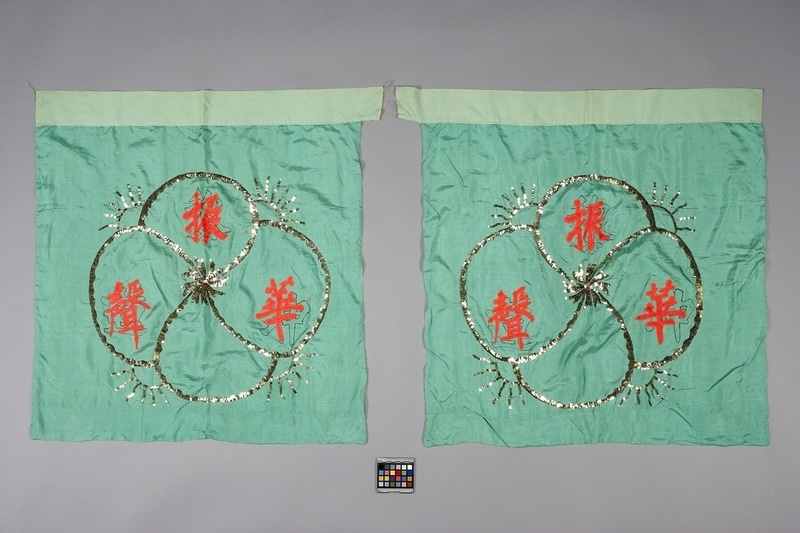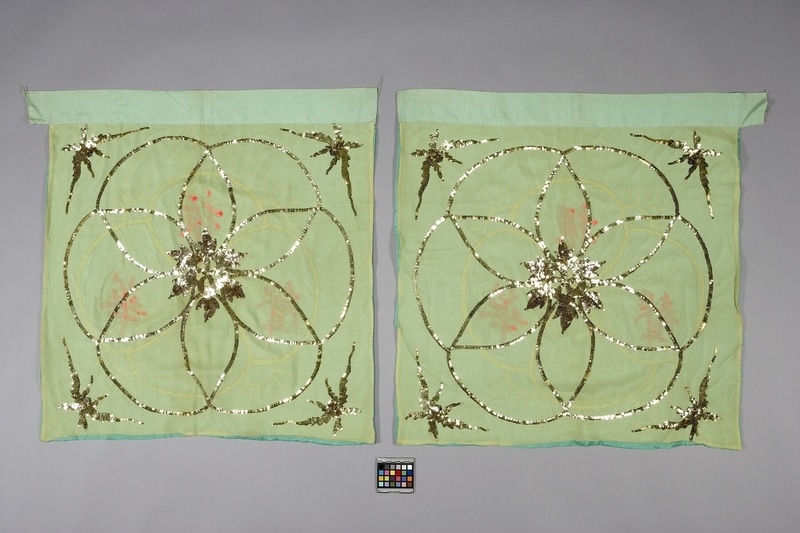Cantonese Opera Tablecloth Item Number: N1.860 a-b from the MOA: University of British Columbia


Description
Green tablecloth panels (part a-b) with sequins. The front has a four-petal floral and sun motifs in gold sequins on a green ground. A red character is painted in three of the four petals. The back has floral, butterfly and sun motifs in gold sequins and yellow dye on yellow-green ground. Across the top is a wide green band for suspension. The two panels are the same.
History Of Use
Table covers are used on the Cantonese opera stage to make tables look finished, decorated, and elegant. They may also give the name of their owner. They do not cover the table, but are attached at the top and hang down at the front. Tables are among the few stage fittings that are used in Cantonese opera. Objects such as tea and wine paraphernalia are placed on them, rulers sit behind them, actors lean on them to show that they are sleeping, and they sometimes jump on them in martial scenes. When red they suggest celebration and happy occasions. Pairs of table covers are rare in stage settings.
Specific Techniques
Machine sewn, except for application of sequins.
Cultural Context
theatre
Iconographic Meaning
Green symbolizes calm and peace.
Narrative
A large group of Cantonese opera costumes, musical instruments, props, trunks, and stage fittings was left with the Jin Wah Sing Musical Association, apparently by some of the many itinerant troupes visiting Vancouver to perform in the Chinatown theatres in the pre World War II period. There is no certain knowledge of why these materials were not taken back to China by them. They were used by the Jin Wah Sing Musical Association in their performances until they became too dated. The association continued to preserve them carefully, storing them in their headquarters and in the basement of the Chinese Freemasons building until several groups of materials were sold and donated to the Museum of Anthropology.
Item History
- Made in Guangzhou, Guangdong, China during 1930
- Collected in Vancouver, British Columbia, Canada
- Owned by Jin Wah Sing Musical Association before August 28, 1973
- Received from Barrett Montford Endowment Fund (Funding source), Jin Wah Sing Musical Association (Seller), Leon & Thea Koerner Foundation (Funding source), Museum of Anthropology Donations Fund (Funding source), Mah Society of North America (Funding source), Canada-China Friendship Association (Funding source), Quon H. Wong Agencies (Funding source) and Edith Low-Beer (Funding source) on August 28, 1973
What
- Name
- Cantonese Opera Tablecloth
- Identification Number
- N1.860 a-b
- Type of Item
- tablecloth
- Material
- silk fibre, rayon fibre ?, gelatin and dye
- Manufacturing Technique
- spun, woven, dyed and sewn
- Part A
- height 81.7 cm, width 82.0 cm
Who
- Culture
- Chinese: Cantonese
- Previous Owner
- Jin Wah Sing Musical Association
- Received from
- Barrett Montford Endowment Fund (Funding source), Jin Wah Sing Musical Association (Seller), Leon & Thea Koerner Foundation (Funding source), Museum of Anthropology Donations Fund (Funding source), Mah Society of North America (Funding source), Canada-China Friendship Association (Funding source), Quon H. Wong Agencies (Funding source) and Edith Low-Beer (Funding source)
Where
- Holding Institution
- MOA: University of British Columbia
- Made in
- Guangzhou, Guangdong, China
- Collected in
- Vancouver, British Columbia, Canada
When
- Creation Date
- during 1930
- Ownership Date
- before August 28, 1973
- Acquisition Date
- on August 28, 1973
Other
- Item Classes
- textiles
- Condition
- good
- Accession Number
- 0248/0245 a-b